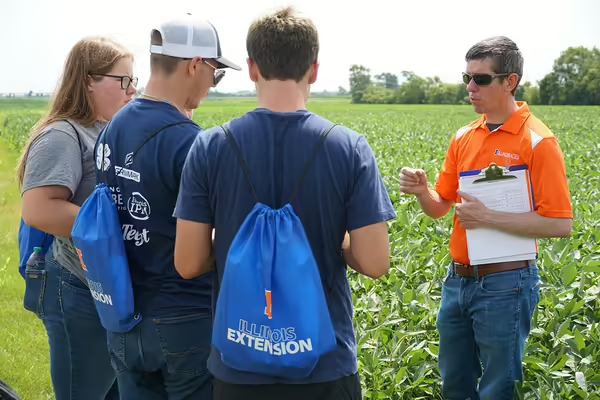
URBANA, Ill. — For youth looking towards a career in agriculture, specifically within the agronomy sector, the Illinois Youth Crop Scouting Competition with University of Illinois Extension is a perfect stop along the way.
Not only can competition experience be added to a resume, but it is a unique opportunity for high school students interested in agriculture to work as a team to explore and help solve today’s crop-related issues. The competition is a platform for students to demonstrate their expertise, skills, and knowledge towards becoming future agriculture professionals.
On Aug. 4, teams of high school students will rotate through various crop testing stations set up in corn and soybean fields to test their knowledge on topics including weeds, insects, disease identification, corn and soybean growth stages, abiotic disorders, pesticide application, and integrated pest management.
“It's exciting when youth and teams return year after year wanting to place higher or earn more points at a certain station,” says Meagan Diss, competition coordinator and commercial ag specialist with Illinois Extension. “That truly shows the impact of the event and dedication the youth have to keep growing.”
Understanding what is happening in today’s farm fields strengthens relationships with growers and provides the advantage of strategically making the best management decisions to maximize yield and profit. Students are helping push the future of agriculture forward by participating in competitions through Extension’s Illinois 4-H and Illinois Association FFA.
University staff will judge the teams to determine results, and the top four teams will win cash prizes sponsored by industry and university partners. Cash prizes awarded to the top four teams include $500, $300, $200, and $100. The top two teams will also advance to represent Illinois at the regional competition hosted this year in Iowa.
"University researchers and Extension experts always look forward to the annual event for the conversations and questions youth bring with them," says Diss. "It's truly an unmatched experience for networking, educational opportunity, and personal growth while having fun."
The competition field rotations begin at 8:30 a.m. to 1:30 p.m. at the University of Illinois Urbana-Champaign Crop Sciences Research and Education Center, 4202 South 1st St., Champaign. Team check-in starts at 8 a.m.
The competition is open to high school students completing grades 9 to 12 in the spring of 2025. Official teams include two to five students, and an adult coach must lead all teams. Teams are encouraged to sign up prior to the end of the current school year, as space is limited to 10 total teams.
For event details or to register teams by July 3, visit go.illinois.edu/CropScouting. New this year, all teams will be required to provide completed release forms, by physical or digital copies, turned in prior to the competition, or the team will not be allowed to participate.
For questions or if you need a reasonable accommodation to participate in this program, contact Meagan Diss at mcdiss@illinois.edu or 217-300-5386. Early requests are strongly encouraged to allow sufficient time to meet access needs.
SOURCE: Meagan Diss, commercial ag specialist, Illinois Extension
WRITER: Jenna Braasch, media communications coordinator, Illinois Extension
University of Illinois Extension develops educational programs, extends knowledge, and builds partnerships to support people, communities, and their environments as part of the state's land-grant institution. Extension serves as the leading public outreach effort for University of Illinois Urbana-Champaign and the College of Agricultural, Consumer and Environmental Sciences in all 102 Illinois counties through a network of 27 multi-county units and over 700 staff statewide. Extension’s mission is responsive to eight strategic priorities — community, economy, environment, food and agriculture, health, partnerships, technology and discovery, and workforce excellence — that are served through six program areas — 4-H youth development, agriculture and agribusiness, community and economic development, family and consumer science, integrated health disparities, and natural resources, environment, and energy.